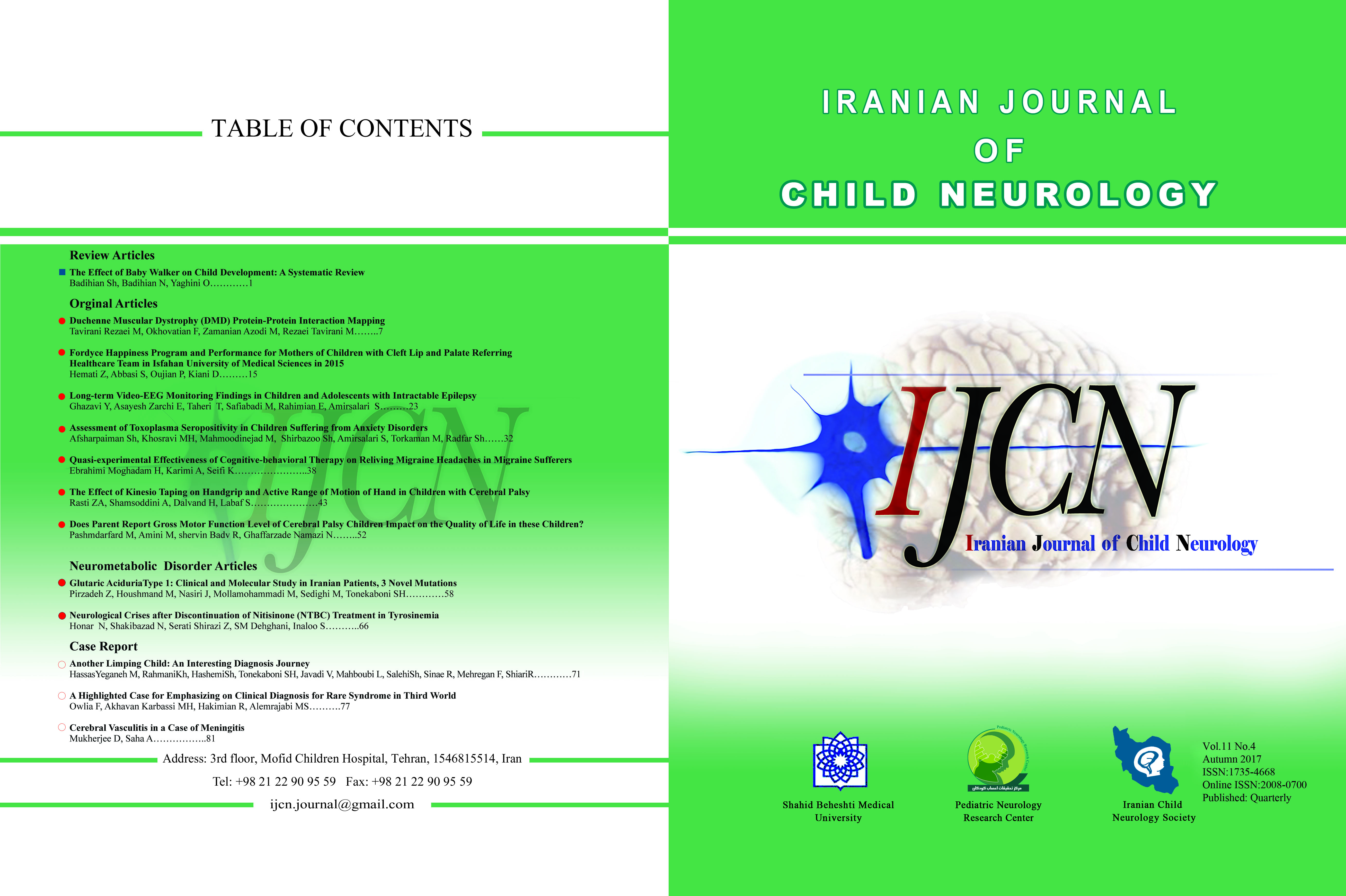Does Parent report gross motor function level of Cerebral palsy children impact on the parent report quality of life in children with cerebral palsy?
Iranian Journal of Child Neurology,
Vol. 11 No. 4 (2017),
13 September 2017
,
Page 52-57
https://doi.org/10.22037/ijcn.v11i4.13545
Abstract
Objective
The aim of this study was to assess the effect of parent report gross motor function level of Cerebral Palsy (CP) children on the parent report quality of life of CP children.
Material & Methods
This study was a cross - sectional study and sampling was done in occupational therapy clinics and CP children’s schools in Zanjan, Iran. In this study the samples size was 60 CP children aged 6-12 years and for sampling method a non-probability convenience sampling method was used. For assessing the quality of life of CP children the cerebral palsy quality of life (CP QOL) questionnaire and for assessing the level of gross motor function of CP children the Gross Motor Function Classification System Family Report Questionnaire (GMFCSFRQ) were used.
Result
The average age of children (22 male and 30 female) was 8.92 years old (minimum 6 years and maximum 12 years). The relationship between the level of gross motor function and participation and physical health was Direct and significant (r=0.65). The relationship between functioning, access to services and family health with the level of gross motor function were direct but were not significant (p >0.05) and the relationship between pain and impact of disability and emotional wellbeing with the level of gross motor function was significant (p<0.05).
- Gross motor function
- quality of life
- cerebral palsy
How to Cite
References
Lim Y, Seer M, Wong C. Impact of cerebral palsy on the quality of life in patients and their families. NEUROL ASIA. 2009; 14:27-33.
Bjornson K, Belza B, Kartin D, Logsdon R, McLaughlin J. Self-reported health status and quality of life in youth with cerebral palsy and typically developing youth. Arch Phys Med Rehab. 2008;89:121-7.
White‐Koning M, Grandjean H, Colver A, Arnaud C. Parent and professional reports of the quality of life of children with cerebral palsy and associated intellectual impairment. Dev Med Child Neurol 2008;50: 618-24.
Kennes J, Rosenbaum P, Hanna S, Walter S, Russell D, Raina P. Health status of school‐aged children with cerebral palsy: information from a populationbased sample. Dev Med Child Neurol. 2002;44(4):240-7.
Kerr C, McDowell B, McDonough S. The relationship between gross motor function and participation restriction in children with cerebral palsy: an exploratory analysis. Child Care Hlth Dev. 2007;33(1):22-7.
Mehraban AH, Hassani M, Amini M. The Comparison of Participation in School-Aged Cerebral Palsy Children and normal Peers: A Preliminary Study. Iran J Pediatr. 2016;26(3):e5303.
Bonomi A, Patrick D, Bushnell D, Martin M. Validation of the United States' version of the World Health Organization Quality of Life (WHOQOL) instrument J Clin Epidemiol. 2000;53(1):1-12.
Bjornson K, McLaughlin J. The measurement of healthrelated quality of life (HRQL) in children with cerebral palsy. European Journal of Neurology 2001;8(5):183–93.
Amini M, Mehraban AH, Haghani H, Asgharnezhad A, Mahani MK. Development and validation of Iranian children’s participation assessment scale. Med J Islam Repub Iran. 2016;30(1):199-209.
Soleimani F, Vameghi R, Kazemnejad A, Fahimi NA, Nobakht Z, Rassafiani M. Psychometric Properties of the Persian Version of Cerebral Palsy Quality of Life Questionnaire for Children. Iran J Child Neurol. 2015;9(1):76-86.
Riahi A, Rassafiani M, Binesh M. the cross- cultural validation and Test-retest and Inter Rater reliability of parent version of the Gross Motor Function Classification System for children with cerebral palsy. journal of rehabilitation. 2013;13(5): 25-30.
Tuzun E, Eker L, Daskapan A, . An assessment of the impact of cerebral palsy on children's quality of life. Fizyoterapi Rehabilitasyon. 2004;15(1):3-8
Livingston M, Rosenbaum P, Russell D, Palisano R, . Quality of life among adolescents with cerebral palsy: what does the literature tell us? Dev Med Child Neurol 2007;49(3):225-31.
NuraniGharaborghe S, Sarhady M, Hosseini S, Mortazavi SS. Relationship between Quality of Life and Gross Motor Function in Children with Cerebral Palsy age 4-12. Medical Journal of Tabriz University of Medical Sciences and Health Services. 2015;37(2):48-5.
Dehno N, Dehkordi S, Dadgoo M, Salehi M. Association between spasticity and the level of motor function with quality of life in community dwelling Iranian young adults with spastic cerebral palsy. Med J Islam Repub Iran. 2012;26(4):150-6.
Mohammed F, Ali S, Mustafa M, . Quality of life of cerebral palsy patients and their caregivers: A cross sectional study in a rehabilitation center Khartoum-Sudan (2014 - 2015). J Neurosci Rural Pract. 2016;7(3):355-61.
Böling S, Varho T, Kiviranta T, Haataja L. Quality of life of Finnish children with cerebral palsy. Disabil Rehabil. 2016;38(7):683-8.
Nilsson S, Johnson E, Adolfsson M. Professionals' Perceptions about the Need for Pain Management Interventions for Children with Cerebral Palsyin South African School Settings. Pain Manag Nurs. 2016;17(4):249-61.
Surender S, Gowda V, Sanjay K, Basavaraja G, Benakappa N, Benakappa A. Caregiver-reported health-related quality of life of children with cerebral palsy and their families and its association with gross motor function: A South Indian study. J Neurosci Rural Pract. 2016;7(2223-7).
- Abstract Viewed: 353 times
